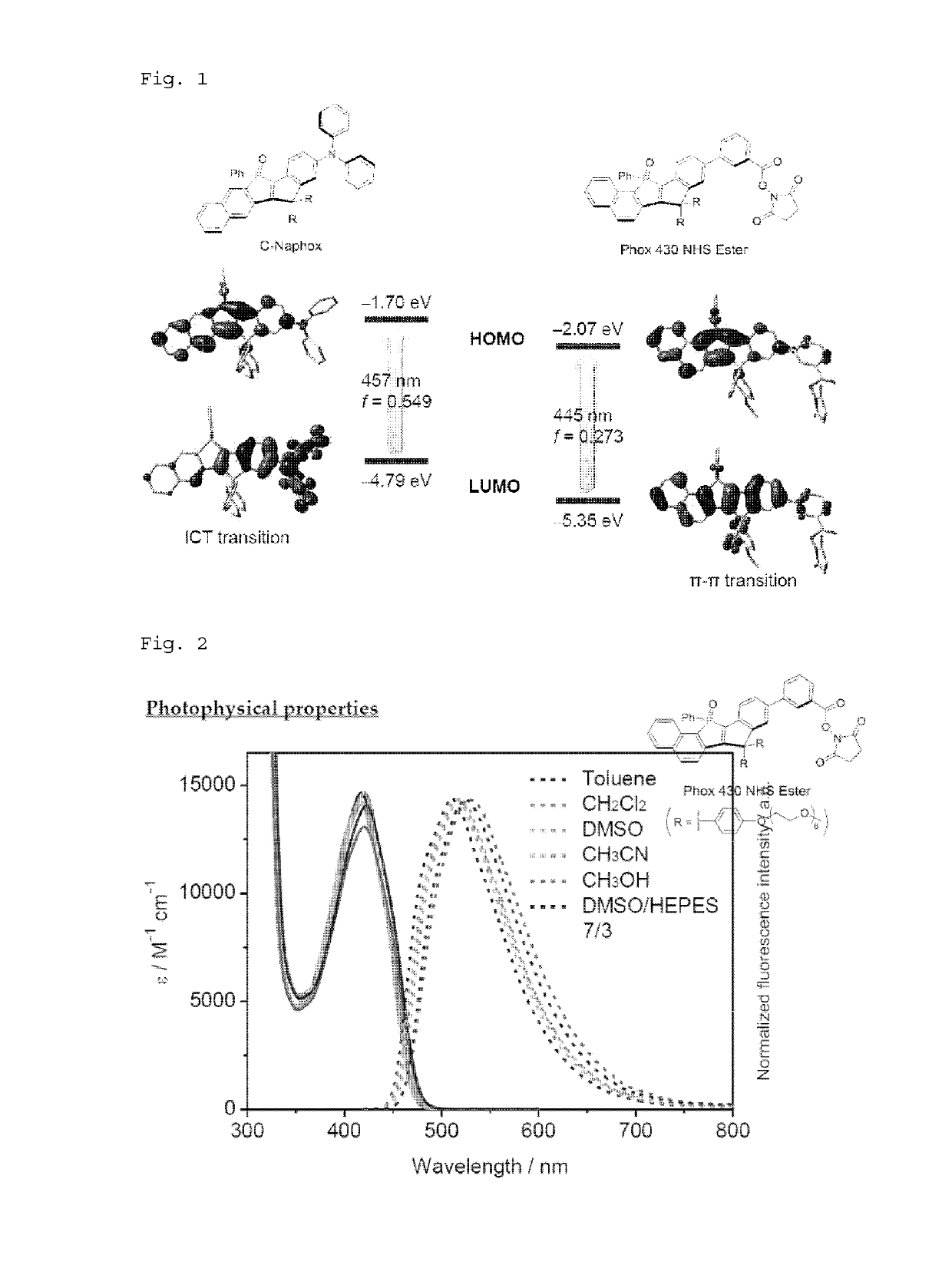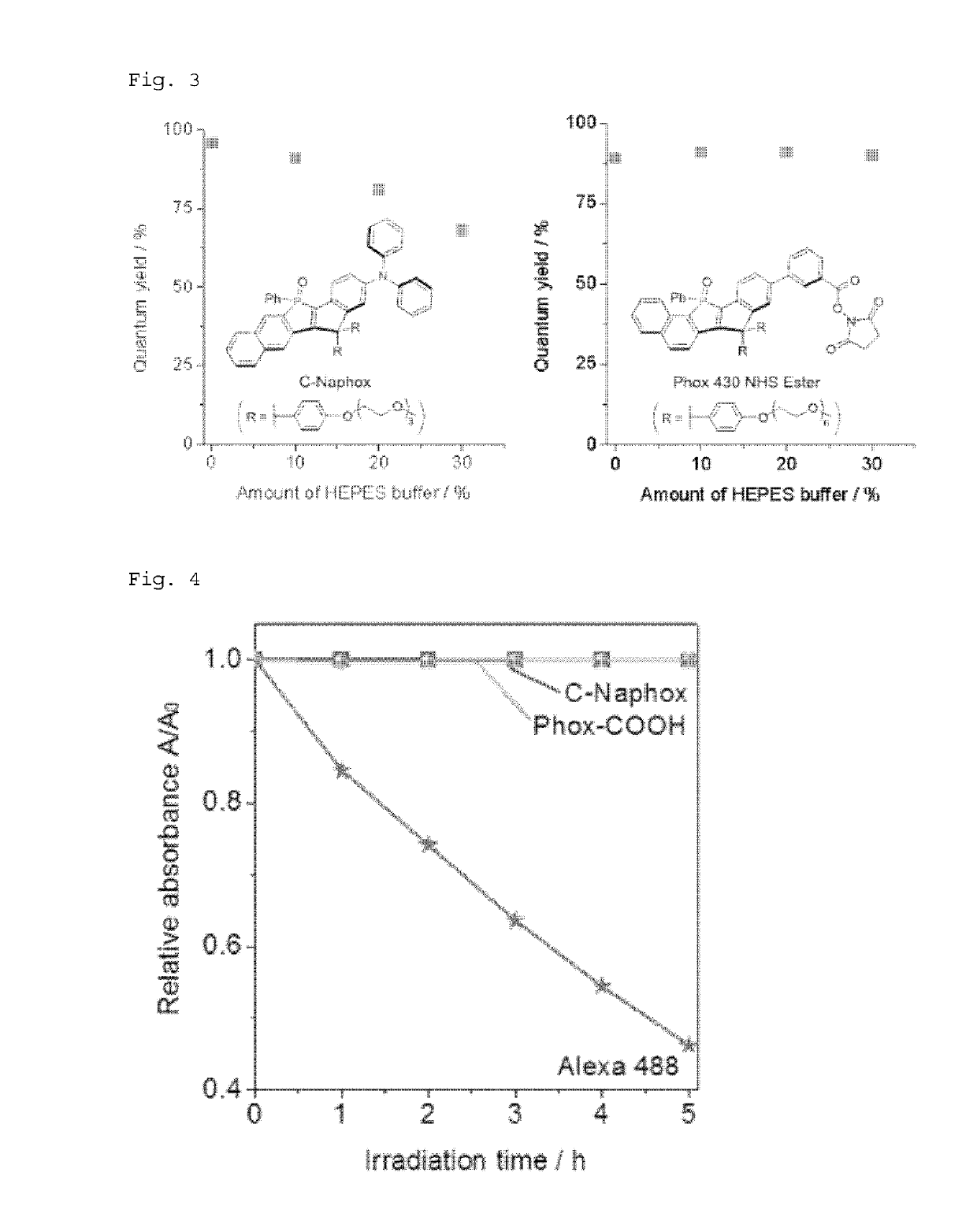Phosphole compound
a compound and phosphorescence technology, applied in the field of phosphorescence compound, can solve the problems of limited object observation by the state-of-the-art fluorescence microscopy technique, difficult observation of repeated super-resolution microscopy, and decomposition of conventionally known fluorescent organic compounds, etc., to achieve enhanced fluorescence quantum yield and high fluorescence quantum yield
- Summary
- Abstract
- Description
- Claims
- Application Information
AI Technical Summary
Benefits of technology
Problems solved by technology
Method used
Image
Examples
synthesis example 1
nd 1 (1-bromo-2-(4-trimethylsilylphenylethynyl)naphthalne)
[0150]
(wherein Tf represents trifluoromethane sulfonyl, TMS represents trimethylsilyl, Pd(PPh3)4 represents tetrakis(triphenylphosphine) palladium (0), and Et3N represents triethylamine; the same applies below). A solution of 1-bromonaphthalen-2-yl triflate (99.44 g, 280 mmol) and 4-trimethylsilylphenylacetylene (48.80 g, 280 mmol) in triethylamine (Et3N; 500 mL) was degassed by bubbling dry nitrogen gas for 20 minutes. After tetrakis(triphenylphosphine)palladium (0) (Pd(PPh3)4; 3.24 g, 2.80 mmol) and CuI (0.533 g, 2.80 mmol) were added, the mixture was stirred at 60° C. for 20 hours. After the mixture was cooled to room temperature, the resulting inorganic salt was removed by filtration, and the filtrate was washed with toluene (200 mL). After all volatile substances were distilled off under reduced pressure, the residue was separated by silica gel column chromatography (hexane, Rf=0.24), and the obtained crude product was r...
synthesis example 2
nd 2 (3-bromo-1-phenyl-2-(4-trimethylsilylphenyl)naphtho[1,2-b]phosphole-P-oxide)
[0152]
(In the formula, tBuLi represents tert-butyl lithium, PhP(NEt2)Cl represents chloro(phenyl)(diethylamino)phosphine, PBr3 represents phosphorus tribromide, and Ph represents phenyl; the same applies below.)
[0153]A 1.60M pentane solution (100.5 mL) of tert-butyl lithium (tBuLi) (160.8 mmol) was added dropwise to a solution of compound 1 of Synthesis Example 1 (30.50 g, 80.4 mmol) in anhydrous tetrahydrofuran (THF; 400 mL) at −78° C. After the mixture was stirred at −78° C. for 1 hour, the resulting suspension was slowly warmed up to −40° C. over 2 hours. After the mixture was cooled to −78° C., chloro(phenyl) (diethylamino)phosphine (PhP(NEt2)Cl; 15.5 mL, 80.5 enol) was added thereto over 0.5 hours. The obtained mixture was slowly warmed up to 0° C. over 0.5 hours. After the mixture was cooled again to −78° C., phosphorus tribromide (PBr3; 7.64 mL, 80.4 enol) was added over 0.5 hours. The obtained m...
synthesis example 3
nd 3
[0155]
(wherein Me represents methyl; the same applies below).
[0156]HSiCl3 (8.07 mL, 80.0 mmol) was added at once to a suspension of compound 2 obtained in Synthesis Example 2 (10.07 g, 20.0 mmol) in anhydrous toluene (30 mL). After the resulting mixture was stirred at 50° C. for 1 hour, all volatiles were distilled off under reduced pressure. Toluene (20 mL) was then added to the resulting mixture, and the obtained suspension was filtered through Celite (registered trademark). The filtrate was washed with toluene (10 mL). After the filtrate was concentrated under reduced pressure, the obtained white solid was suspended in anhydrous diethyl ether (Et2O; 100 mL). A 1.60M pentane solution (25.0 mL) of tert-butyl lithium (tBuLi) (40.0 mmol) was added to this suspension at −78° C. over 30 minutes. After the resulting mixture was stirred at the same temperature for 2 hours, 4,4′-dimethoxybenzophenone (4.85 g, 20.0 mmol) was added, and the obtained mixture was slowly warmed to room tem...
PUM
| Property | Measurement | Unit |
|---|---|---|
| wavelength | aaaaa | aaaaa |
| wavelength | aaaaa | aaaaa |
| wavelength | aaaaa | aaaaa |
Abstract
Description
Claims
Application Information
 Login to View More
Login to View More - R&D
- Intellectual Property
- Life Sciences
- Materials
- Tech Scout
- Unparalleled Data Quality
- Higher Quality Content
- 60% Fewer Hallucinations
Browse by: Latest US Patents, China's latest patents, Technical Efficacy Thesaurus, Application Domain, Technology Topic, Popular Technical Reports.
© 2025 PatSnap. All rights reserved.Legal|Privacy policy|Modern Slavery Act Transparency Statement|Sitemap|About US| Contact US: help@patsnap.com



